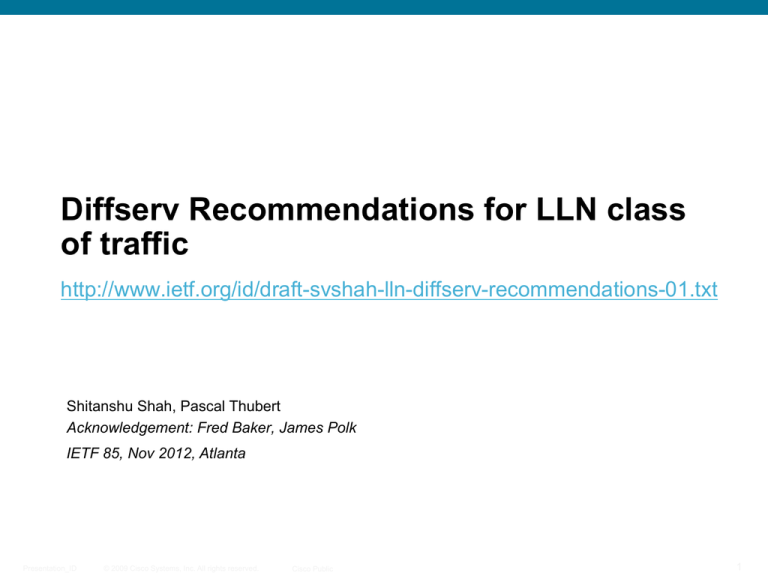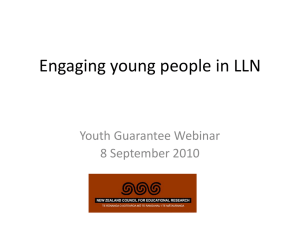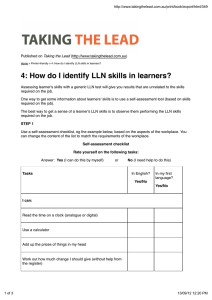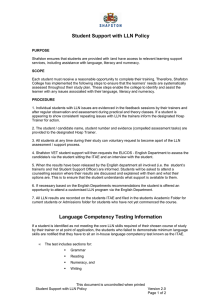
Diffserv Recommendations for LLN class
of traffic
http://www.ietf.org/id/draft-svshah-lln-diffserv-recommendations-01.txt
Shitanshu Shah, Pascal Thubert
Acknowledgement: Fred Baker, James Polk
IETF 85, Nov 2012, Atlanta
Presentation_ID
© 2009 Cisco Systems, Inc. All rights reserved.
Cisco Public
1
Brief on LLN
Motivation
Scope
LLN Traffic Classes
Proposed Recommendations
Deployment Scenario
Next Steps
Questions
2
LLN – Low Power and Lossy Networks (aka M2M, IoT)
Examples – Industrial automation, Home automation, Building automation, Urban automation etc
Growing in large numbers
Including with a requirement of traffic over IP back bone, over converged campus network
Converged Campus Network
Gateway
IP Backbone
LLN Border Routers (LBR)
M
LLN
3
RFC4594 has well documented recommendation for traditional
class of traffic (eg. Media-oriented traffic)
RFC is not clear for LLN class of traffic
Categorize LLN Traffic Classes
Taking 4594 as a reference, define explicit recommendations for
LLN traffic classes
4
Traffic from LLN Border towards IP Backbone, converged campus
network
Source nodes (or application gateways) to mark appropriate dscp
code-point
Traffic in the Reverse direction
Due to physical constraints and unique characteristics, LL
Networks themselves may require other considerations for perhop forwarding/behavior
5
Traffic
Traffic Class Characteristics
Class Name
Tolerance to
Loss
Delay
Jitter
Alerts/alarms
Packet size = small, Rate = typically 1-few packets
Short lived flow, Burst = not bursty
Low
Low
N/A
Control Signals
Packet size = variable, typically small, Rate = few
packets
Short lived flow, Burst = none to some-what
Low
Low
Yes
Low latency
closed-loop
control signals
Packet size = variable, typically small, Rate = few
packets
Short lived flow, Burst = none to some-what
Latency/Jitter sensitive
Low
Very Low
Low
Video
monitoring/feed
Packet size = big, Rate = variable
Long lived flow, Burst = non-bursty
Low
Low –
Medium
Low
Query-based
data
Packet size = variable, Rate = variable
Short lived elastic flow, Burst = bursty
Low
Medium
Yes
Periodic
reporting/log,
Software
downloads
Variable packet size, rate burst
Yes
Medium High
Yes
6
- Alert Signals
CS5
- Control Signaling
CS5
(only for latency sensitive?
or for all important ones to distinguish it as a different service class?)
- Low latency closed-loop control-signals
EF
?
(incl. jitter sensitive)
- Video broadcast/feed
CS3
- Query-based data
AF2x
- Assured monitoring data (high throughput)
AF1x
- Best effort monitoring, periodic reporting
BE
7
Safety
- Class 0: Emergency action : It is expected to use other tightly managed method
outside of IP networks
Control
- Class 1: Closed-loop regulatory control
EF
- Class 2: Closed-loop supervisory control
CS5
- Class 3: Open-loop control
CS5
Monitoring
- Class 4: Alerting - Short-term operational effect
AF2x
- Class 5: Logging and downloading /uploading
AF1x/BE
8
9
Questions?
10




